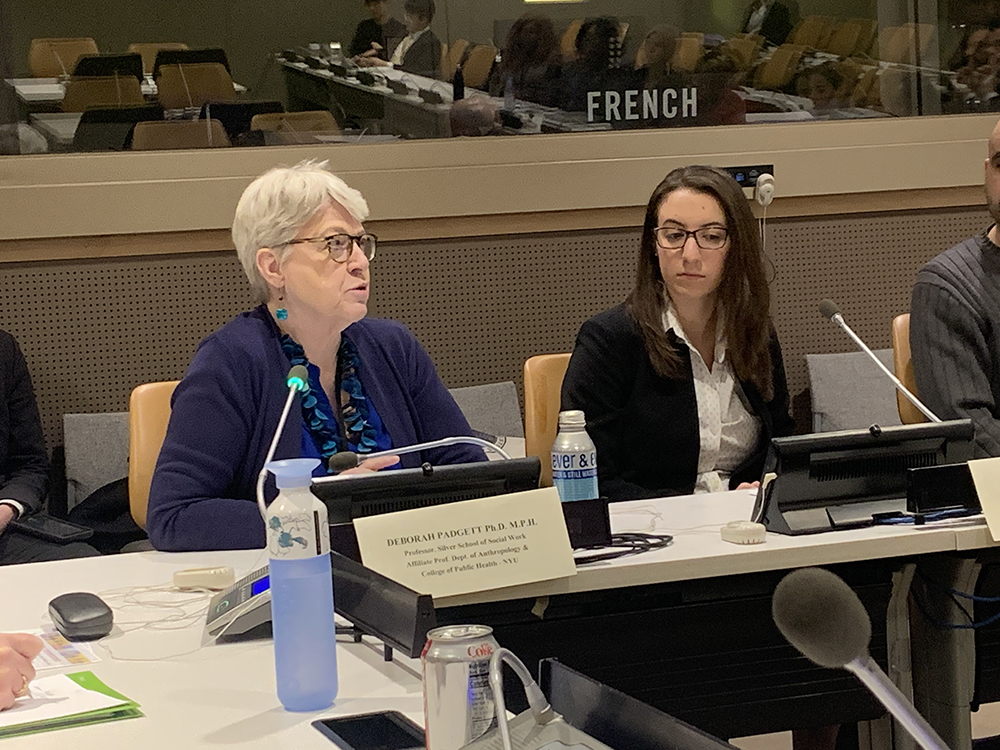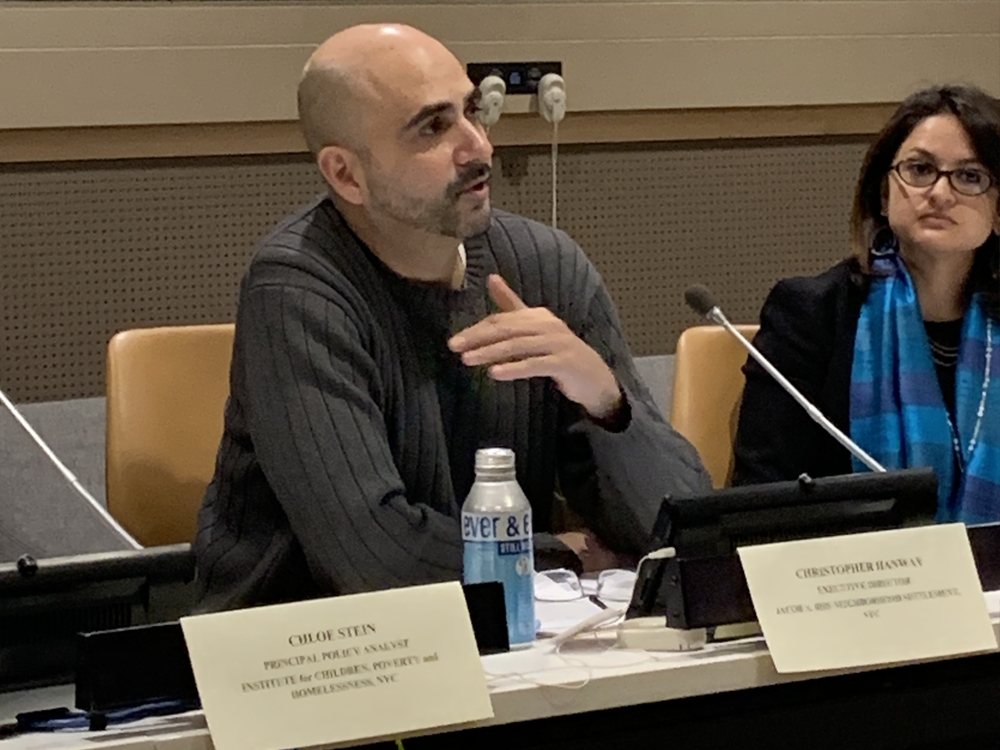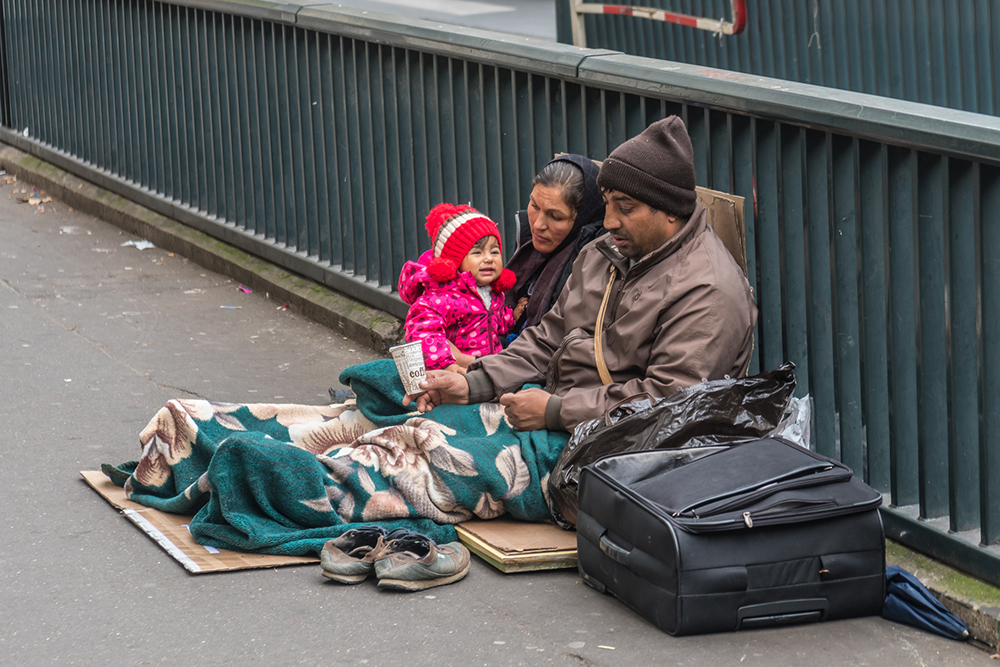.jpg)
► Event highlights

Panelists
- Suna Hanoz-Penney, MA (Moderator) - Director of International Program, AÇEV-Mother Child Education Foundation (Turkey); Executive Committee member, Early Childhood Peace Consortium (ECPC). "Homelessness and the Transformative Power of Early Childhood Development"
- Deborah K. Padgett, PhD, MPH - New York University Professor at the Silver School of Social Work and Affiliate Professor at the Department of Anthropology and the College of Global Public Health. "The Impact of Homelessness on Children and Families: Examining the Evidence”
- Chloe Stein, MA - Principal Policy Analyst, Institute for Children, Poverty, and Homelessness, NYC. "Examining the Long-Lasting Impact of Homelessness on Children”
- Christopher Hanway, MA - Executive Director, Jacob A. Riis Neighborhood Settlement, NYC. "Educating Homeless Children: The Family Literacy Approach”
- Nada Elattar, MPH - Early Childhood Development (ECD) Specialist in Emergencies at UNICEF, Headquarters in NYC; Secretary, Early Childhood Peace Consortium (ECPC). "Survive and Thrive - Supporting Young Children and Families Impacted by Humanitarian Situations"
► Read the panelists' biographies.
Acknowledgements & Gratitude
►Talk summaries
Talk 1. Homelessness and the Transformative Power of Early Childhood Development

Talk 2. The Impact of Homelessness on Children and Families: Examining the Evidence

- The impact of homelessness is even worse than the impact of extreme poverty on families. Shelters do not accommodate families with children who are forced to move from location to location. Instability in housing and schooling leads to negative educational outcomes for children.
- Adverse childhood experiences (ACEs), e.g., trauma and abuse during childhood, have long lasting damaging effects on children that reach into adulthood. Homeless children are at greater risk for such adverse conditions. This is especially the case when children are separated from their families by child welfare authorities without cause, beyond the fact that the family is falling into homelessness.
- Racism has contributed to family homelessness in a way that is often not acknowledged by policy makers. Wealth extraction from African American communities that has gone on for decades is why the majority of the chronically homeless are African American. Decades of concentrated economic disadvantage have put African Americans at great risk for homelessness.
Talk 3. Examining the Long-Lasting Impact of Homelessness on Children
.png) Chloe Stein is a principal policy analyst for the Institute for Children, Poverty, and Homelessness (ICPH), a policy research organization focused on child and family homelessness in New York city and throughout the United States. Ms. Stein remarked that homelessness disproportionately impacts young children: 1) one in every 100 babies born in New York City hospitals are brought home to a shelter; and 2) almost half of all children in New York city family shelters are under the age of six.
Chloe Stein is a principal policy analyst for the Institute for Children, Poverty, and Homelessness (ICPH), a policy research organization focused on child and family homelessness in New York city and throughout the United States. Ms. Stein remarked that homelessness disproportionately impacts young children: 1) one in every 100 babies born in New York City hospitals are brought home to a shelter; and 2) almost half of all children in New York city family shelters are under the age of six. - Half of homeless high school students reported experiencing depression.
- Nearly one in three homeless high school students had attempted suicide.
- Homeless high school students were five times more likely to experience dating violence.
- Homeless high school students were seven times more likely to have been pregnant or to have gotten someone pregnant, potentially furthering the cycle of trauma and homelessness.
“A family's experience with financial instability or domestic abuse doesn't suddenly disappear once the family gets a home of their own. While affordable housing is absolutely essential, it must be accompanied by wraparound services for parents and their children, like job training, support for victims of domestic violence, financial literacy, childcare services and access to physical and mental health care.”
Talk 4. Educating Homeless Children: The Family Literacy Approach

- Adult education: Parents become the primary teachers and full partners in the education of their children.
- Parent time: Literacy training can lead to a parent’s own economic and social development, especially if he/she is a migrant and English is not his/her primary language.
- Children’s education: Age appropriate education for children helps prepare them for success in school and in life, with emphasis on literacy and numeracy.
- PACT Time, Parent and Child Together time: A scheduled time when a parent and child engage in child-led literacy and numeracy activities that foster reciprocal learning.
- More sophisticated language skills in children have been linked to parent literacy skills and shared reading.
- Children from high income earning families hear 20 million more words by the age of three than children from high poverty families.
- Family literacy programs that incorporate vocational skills training increase employment opportunities for parents and helps break the cycle of low socioeconomic outcomes and low literacy.
Talk 5. Survive and Thrive -Supporting Young Children and Families Impacted by Humanitarian Situations

- Provide enough paid leave to all parents, in both the formal and informal economies, to meet the needs of their young children
- Provide breaks and support so that mothers can breastfeed exclusively for 6 months
- Ensure that all children have access to affordable, quality childcare and early education
- Provide child benefits and adequate wages to help all families provide for young children
“Governments, businesses, civil society and families can come together to ensure that children SURVIVE and THRIVE and can realize their full potential, - breaking the vicious cycle of poverty and vulnerability, and realizing their rights to social security irrespective of their status. At UNICEF, we have started to say: It’s about time.”
Conclusion: key points on how homelessness affects children and families

- Environmental exposures during early development are pivotal.
- The global crisis of conflict and homelessness has a huge impact of on the well-being of children worldwide.
- A multidisciplinary approach is needed to combine scientific, practical and political work that is being done in this area.
- Family homelessness has a social problem of great magnitude that is underappreciated due to most homeless families living in the shelter system.
- Housing should not be seen as something that needs to be earned, as it is a universal human right.
- Family homelessness in the United States can be tackled far more efficiently, as seen when compared to the successes in the homeless veteran population, suggesting the importance of an adequate political will.
- The impact of homelessness on families is even greater than that of extreme poverty.
- Homeless children are at a greater risk for adverse childhood experiences, like trauma and abuse which may have long lasting damaging effects.
- Racism needs to be considered as the great problem it is by policy makers since decades of economic disadvantage and wealth extraction from African American communities have contributed to family homelessness and chronical homelessness in African Americans.
- A large number of babies and children in New York City are homeless.
- Homeless children experience educational disadvantages throughout their lives. Pre-K education can be helpful in ameliorating such disadvantages.
- Early Childhood Education can provide homeless children with a sense of stability.
- Support for homeless parents and children needs to go beyond housing; necessary services include job training, support for victims of domestic violence, financial literacy, childcare services and access to physical and mental health care.”
- Family Literacy is a multi-generational approach that recognizes the parent or familial caregiver as the primary educator for their child.
- Educating the parents and improving the parent and child together time are important for the Family Literacy model which researchers find to be highly efficient.
- There is an alarming contrast between the notion that all children have the rights to protection, development and health and the fact that masses of families and children around the globe live in adverse conditions, such as poverty and homelessness, that do not support early childhood development.
- Nurturing care, made up of good health, adequate nutrition, responsive caregiving, security and safety and opportunities for early learning, can lessen the effects such adversity.
- Family Friendly Policies are crucial for families, economies and the overall development of nations.
More information
Publications
- National Center for Homeless Education. (2020). Federal data summary: School years 2015-2016 through 2017-2018, Education for homeless children and youth.
- GlobalGiving. (2019). Housing now! 2020.
- Shah S. (2019). Early Childhood Development in Humanitarian Crises. South Sudanese Refugees in Uganda, 1st Edition. Routledge
- UNANIMA International. (2019). The impact of personal and family circumstances on homelessness.
- UNANIMA International. (2019). Famly homelessness: Through the lens of the United Nations 2030 agenda.
- European Federation of National Organisations Working with the Homeless (FEANTSA). (2013). Homelessness Amongst Immigrants in the EU– A Homeless Service Providers’ Perspective.
- OECD. (2011). Perspectives on Global Development 2012: Social Cohesion in a Shifting World, OECD Publishing, Paris.
UNICEF resources
- UNICEF ECDiE Case Studies
- UNICEF ECDiE Kit for Emergencies Evaluation Synthesis
- UNICEF ECDiE Kit Guide
- UNICEF Fact Sheet. Early Childhood Development in Emergencies
- UNICEF. (2018). Every child survives and thrives: Global annual results report 2018. (See section on ECD.)
News
- Ziveri, M. (2020). Is Youth Homelessness Going Up or Down? It Depends on Whom You Ask. New York Times, March, 2020.
- Ziveri, M. (2020). Number of Homeless Students Rises to New High, Report Says. New York Times, February, 2020.
- Shapiro, E. (2019). 114,000 Students in N.Y.C. Are Homeless. These Two Let Us Into Their Lives.
- Barua A, Frey R, Suriya N, & Byrnes K. (2019). The homelessness paradox: Why do advanced economies still have people who live on the streets? Deloitte Insights. 25 Sept, 2019.
- Kuo G. (2019). Yet another emerging global crisis- Homelessness. Millennium Alliance for Humanity and the Biosphere (MAHB). August, 2019.
Links
- Family homelessness
- Organisation for Economic Co-operation and Development (OECD). Social cohesion.

